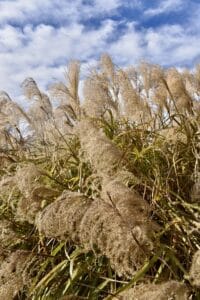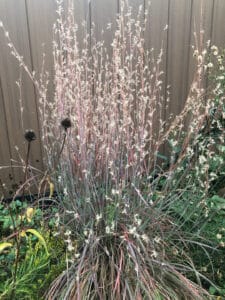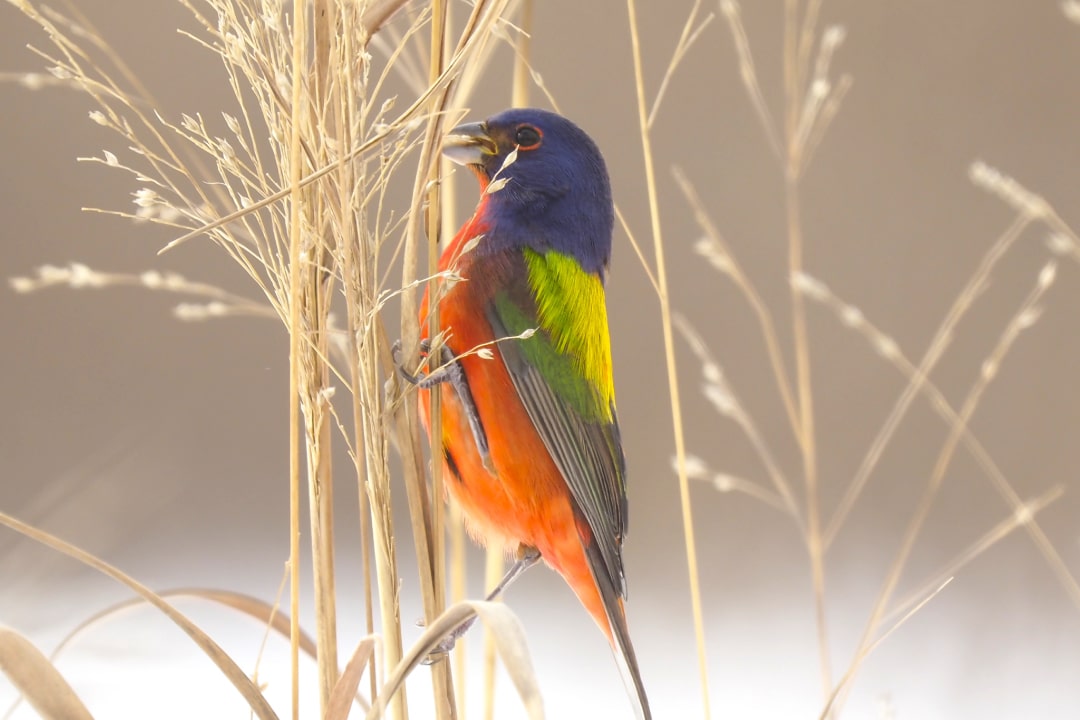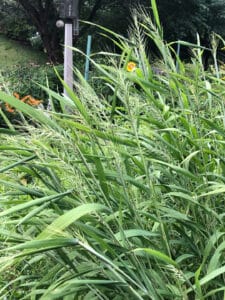Non-native species aren’t inherently bad, and not all non-native species become invasive. However, we should thoughtfully consider our landscaping choices, particularly when heading to our local garden center. Here in North America, a cheerful grouping of blooming tulips with origins in Eurasia isn’t likely to creep into our meadows and forests and form a monoculture. Nonetheless, if we read the landscape across many areas of the mid-Atlantic, we’ll easily find other plants from the nursery trade that have escaped cultivation and are growing where they weren’t planted.
English ivy, Japanese barberry, periwinkle, and burning bush, among many other familiar culprits, have all escaped garden cultivation — and they can quickly displace native plants. The Mid Atlantic Invaders Tool identifies over 600 invasive (or at-risk for becoming invasive) plant species in our region. Over half of these species have origins as landscape ornamentals.
Unfortunately, plants with invasive tendencies aren’t as quick to make their way onto state agency lists that would restrict their sale or propagation. A surprising number of them are still readily available for sale at your favorite nursery — unless your favorite nursery is one that specializes in natives.

Have you seen this fluffy seedhead of Miscanthus sinensis? Photo credit: Cathy DeWitt CC BY-NC-ND 4.0
Here I’ll focus on ornamental grasses, particularly on natives you might consider instead of widely available invasives, such as maiden grass (Miscanthus sinensis) and fountain grass (Pennisetum alopecuroides), both native to Asia.
With an upright growth habit and showy plumes, maiden grass, also known as Chinese silver grass, has gained popularity as a specimen planting since its introduction to the United States in the 1800s. Maiden grass is self-incompatible, and is less likely to set viable seed when grown in isolation. However, the likelihood of self-seeding increases when planted in proximity to other cultivars (Meyer 2003). When that happens, wind can carry upward of 1,000 seeds per plant into the surrounding landscape.
A quick search on a local garden center website revealed a stock of over a dozen maiden grass cultivars available for sale this spring. A few of them are promoted as non-invasive and sterile, but I’d rather exercise caution, and dedicate that space in my garden to a native grass that supports more wildlife instead. Just like native trees, shrubs, and herbaceous perennials, native grasses are important host plants to butterfly and moth larvae. They can play just as important a role as flowering perennials in supporting pollinators. The structure of native bunch grasses can also provide winter shelter and nesting habitat for other insects and native bees.
Maiden and fountain grass among others have been widely planted in residential, commercial, and public spaces. However, a few native grasses are quietly asserting their places in the standard garden center line-up of non-native options and with good reason, aesthetically and ecologically. Let’s take a look at a few of these native grasses that are becoming more common commercially, and easier to find at local garden centers.
Little Bluestem

Little Bluestem. Photo Credit: Christa Shoreman
A warm-season native bunch grass growing two to four feet tall, little bluestem (Schizachyrium scoparium) is a lovely addition to any landscaped setting, with its blue green foliage during the summer months shifting into rich fall hues of copper, pink and burgundy. Whimsical, fluffy seeds persisting into winter months are valuable to songbirds and small mammals. The Xerces Society, which advocates for invertebrate conservation, reports that little bluestem is a larval host plant for nine species of skipper butterflies. Once established, the plant is very drought tolerant, with fibrous roots reaching up to five feet deep. Happiest in full sun and well-drained, lean soil, little bluestem is compact, clumping, and hard not to love! Well-behaved enough for small spaces, it is beautifully grown on its own but can also add vertical structure and movement to a mixed planting.
Switchgrass
Another warm-season bunchgrass with deep roots, switchgrass (Panicum virgatum) is tough and easy to grow. Growing a bit taller than little bluestem, 3 to 6 feet, it is a solid native replacement for maiden grass. Its high ornamental value makes for a great herbaceous border or privacy screen anywhere with full sun. More tolerant of soil moisture than other grasses, switchgrass also has functional value in rain gardens. Airy panicles form small seeds, attractive to songbirds. Avoid fertilizer or soil amendments, which can cause flopping.

Switchgrass offered nutritious forage to this out-of-range Painted Bunting, observed feeding on seeds. Photo Credit: Warren Wolf
Bottlebrush Grass

Bottlebrush. Photo Credit: Christa Shoreman
A cool-season grass, bottlebrush grass (Elymus hystrix) grows when temperatures are cooler in the spring and fall. It’s a nice, textural addition to shadier areas with dappled sunlight under trees or along woodland edges, though it doesn’t do well in full shade. Bottlebrush grass grows 2-5 feet tall, with its delicately bristled seedheads (hence the name) rising a foot or so above the foliage. It is a host plant for the larva (caterpillar) of the northern pearly eye butterfly and for some native moth species. White-footed mice are known to dine on its seeds.
These are just three native grasses becoming more widely available. There are plenty more to choose from! The U.S. Forest Service recommends three more as alternatives to maidengrass in particular — split-beard bluestem (Andropogon ternarius), sugarcane plumegrass (Saccharum giganteum) and Indiangrass (Sorghastrum nutans).
A 2017 survey of mid-Atlantic wholesale nurseries conducted by Mt. Cuba Center in Hockessin, DE, found that 25% of all the plants sold are native species. That’s a good start, but not quite enough if we are serious about safeguarding biodiversity in our communities, while making up for habitat loss and other impacts of climate change. Like any industry, the nursery trade will always respond to demand. Our landscaping choices have impacts far beyond our own yards. They can and do matter.
For more information on native plants you can use to improve your own space, visit our Native Plant Center!
